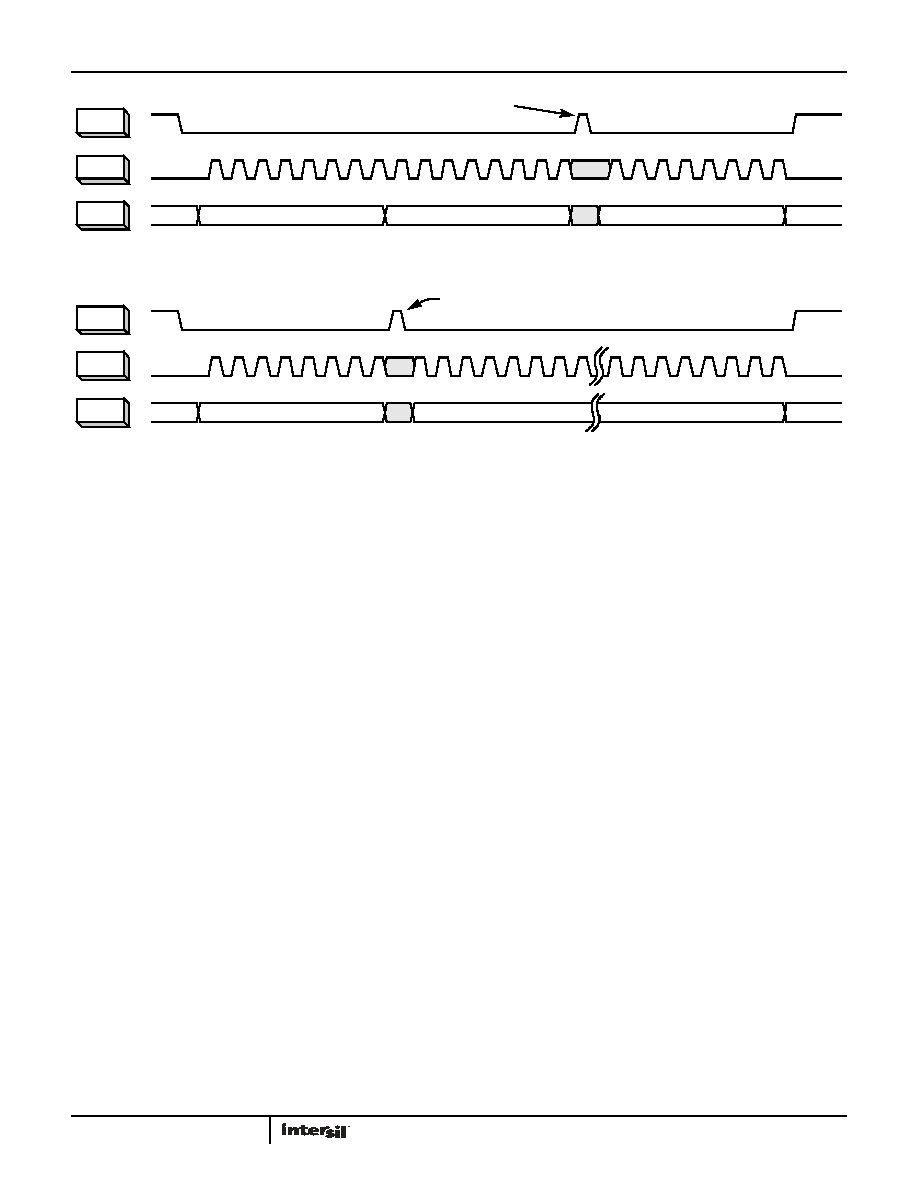- 您現(xiàn)在的位置:買賣IC網(wǎng) > PDF目錄2002 > ISLA214S50IR1Z (Intersil)IC ADC PDF資料下載
參數(shù)資料
| 型號: | ISLA214S50IR1Z |
| 廠商: | Intersil |
| 文件頁數(shù): | 19/41頁 |
| 文件大小: | 0K |
| 描述: | IC ADC |
| 標(biāo)準(zhǔn)包裝: | 1 |
| 系列: | * |
第1頁第2頁第3頁第4頁第5頁第6頁第7頁第8頁第9頁第10頁第11頁第12頁第13頁第14頁第15頁第16頁第17頁第18頁當(dāng)前第19頁第20頁第21頁第22頁第23頁第24頁第25頁第26頁第27頁第28頁第29頁第30頁第31頁第32頁第33頁第34頁第35頁第36頁第37頁第38頁第39頁第40頁第41頁

ISLA214S50
26
FN7973.2
April 25, 2013
Serial Peripheral Interface
A serial peripheral interface (SPI) bus is used to facilitate
configuration of the device and to optimize performance. The SPI
bus consists of chip select (CSB), serial clock (SCLK) serial data
output (SDO), and serial data input/output (SDIO). The maximum
SCLK rate is equal to the ADC sample rate (fSAMPLE) divided by 14
for write operations and fSAMPLE divided by 32 for reads. There is
no minimum SCLK rate.
The following sections describe various registers that are used to
configure the SPI or adjust performance or functional parameters.
Many registers in the available address space (0x00 to 0xFF) are
not defined in this document. Additionally, within a defined
register there may be certain bits or bit combinations that are
reserved. Undefined registers and undefined values within defined
registers are reserved and should not be selected. Setting any
reserved register or value may produce indeterminate results.
SPI Physical Interface
The serial clock pin (SCLK) provides synchronization for the data
transfer. By default, all data is presented on the serial data
input/output (SDIO) pin in three-wire mode. The state of the SDIO
pin is set automatically in the communication protocol
(described in the following). A dedicated serial data output pin
(SDO) can be activated by setting 0x00[7] high to allow operation
in four-wire mode.
The SPI port operates in a half duplex master/slave
configuration, with the ADC functioning as a slave. Multiple slave
devices can interface to a single master in three-wire mode only,
since the SDO output of an unaddressed device is asserted in
four wire mode.
The chip-select bar (CSB) pin determines when a slave device is
being addressed. Multiple slave devices can be written to
concurrently, but only one slave device can be read from at a
given time (again, only in three-wire mode). If multiple slave
devices are selected for reading at the same time, the results will
be indeterminate.
The communication protocol begins with an instruction/address
phase. The first rising SCLK edge following a high-to-low
transition on CSB determines the beginning of the two-byte
instruction/address command; SCLK must be static low before
the CSB transition. Data can be presented in MSB-first order or
LSB-first order. The default is MSB-first, but this can be changed
bit ordering for the MSB-first and LSB-first modes, respectively. In
MSB-first mode, the address is incremented for multi-byte
transfers, while in LSB-first mode it’s decremented.
In the default mode, the MSB is R/W, which determines if the
data is to be read (active high) or written. The next two bits, W1
and W0, determine the number of data bytes to be read or
written (see Table 6). The lower 13 bits contain the first address
for the data transfer. This relationship is illustrated in Figure 44,
and timing values are given in “Switching Specifications” on
After the instruction/address bytes have been read, the
appropriate number of data bytes are written to or read from the
ADC (based on the R/W bit status). The data transfer will
continue as long as CSB remains low and SCLK is active. Stalling
of the CSB pin is allowed at any byte boundary
(instruction/address or data) if the number of bytes being
transferred is three or less. For transfers of four bytes or more,
CSB is allowed to stall in the middle of the instruction/address
bytes or before the first data byte. If CSB transitions to a high
state after that point the state machine will reset and terminate
the data transfer.
FIGURE 46. 2-BYTE TRANSFER
CSB
SCLK
SDIO
INSTRUCTION/ADDRESS
DATA WORD 1
DATA WORD 2
CSB STALLING
FIGURE 47. N-BYTE TRANSFER
CSB
SCLK
SDIO
INSTRUCTION/ADDRESS
DATA WORD 1
DATA WORD N
LAST LEGAL
CSB STALLING
相關(guān)PDF資料 |
PDF描述 |
|---|---|
| ISLA222P13IRZ | IC ADC 12BIT SRL/SPI 72QFN |
| ISLA224S25IR1Z | IC ADC |
| KAD2708C-27Q68 | IC ADC 8BIT 275MSPS PAR 68-QFN |
| KAD2708L-27Q68 | IC ADC 8BIT 275MSPS PAR 68-QFN |
| KAD2710C-27Q68 | IC ADC 10BIT 275MSPS PAR 68-QFN |
相關(guān)代理商/技術(shù)參數(shù) |
參數(shù)描述 |
|---|---|
| ISLA214S50IR48EV1Z | 制造商:Intersil Corporation 功能描述:ISLA214S50IRZ EVALUATION BOARD 1 48LD QFN ROHS COMPLIANT - Bulk 制造商:Intersil Corporation 功能描述:ISLA214S50IRZ EVALUATION BOARD 1 48LD QFN ROHS COMPLIANT |
| ISLA216IR72EV1Z | 制造商:Intersil Corporation 功能描述:ISLA216IR72 EVAL BOARD - 72 LD QFN - SINGLE 16-BIT 250MSPS U - Bulk 制造商:Intersil Corporation 功能描述:EVAL BOARD FOR ISLA216IR72 制造商:Intersil Corporation 功能描述:EVAL BOARD ADC ISLA216P 制造商:Intersil Corporation 功能描述:EVAL BOARD, ADC, ISLA216P 制造商:Intersil 功能描述:ISLA216IR72 EVALRD 72LD SNGL 16-BIT 制造商:Intersil Corporation 功能描述:EVAL BOARD, ADC, ISLA216P; Silicon Manufacturer:Intersil; Silicon Core Number:ISLA216P; Kit Application Type:Data Converter; Application Sub Type:ADC; Kit Contents:Evaluation Board for ISLA216P ADC |
| ISLA216P | 制造商:INTERSIL 制造商全稱:Intersil Corporation 功能描述:16-Bit, 250MSPS/200MSPS/130MSPS ADC |
| ISLA216P_1104 | 制造商:INTERSIL 制造商全稱:Intersil Corporation 功能描述:16-Bit, 250MSPS/200MSPS/130MSPS ADC |
| ISLA216P13 | 制造商:INTERSIL 制造商全稱:Intersil Corporation 功能描述:12-Bit, 500MSPS ADC Programmable Built-in Test Patterns |
發(fā)布緊急采購,3分鐘左右您將得到回復(fù)。